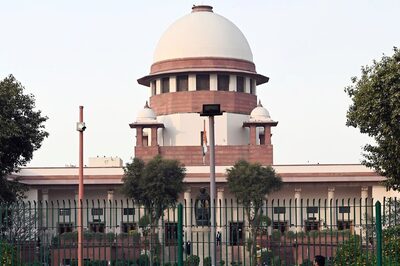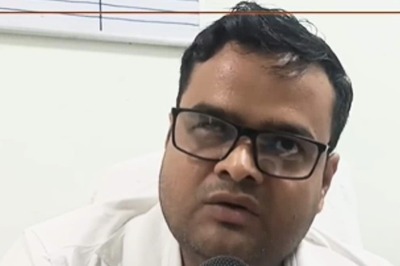Recipe for Drought: As Farmer Distress Topped 2019 Poll Talk, Did Leaders Miss Out on Actual Action?

views
Nagpur: The sun was blisteringly hot. We stood in front of a forlorn field which was burning in the absence of water or moisture — rows of guava plants spread over three acres were wilting and its owner couldn’t do anything to stop it from dying. This was in May first week. The orchard owner cried like a child.
“I can’t stand here watching my plants die,” he bemoaned, “I have no water or money to buy water”.
This was in Beed, one of Maharashtra’s perpetually drought-prone districts. In 2018, it rained less than 50 per cent in this village of Vadgaon Dhoke. People knew they had a horrifying summer ahead.
They began to prepare for an exigency long back knowing a drought would soon engulf them. They expected their state government to be alive and alert to their inevitable hardship. They were wrong. Not only was their government asleep, it was flamboyant in spending on ads and propaganda for the ensuing Lok Sabha elections, which are now in their last leg.
No one cared for the farmers or their worries amidst a pitched battle for the throne of New Delhi.
But for one district of Beed, the other equally worse-affected districts haven’t been permitted to open the fodder and cattle camps in numbers that would meet the demand. Right now, over a thousand such cattle camps are functioning, 650 of them in Beed district alone. And yet, their financial requirements have been given an administrative nod.
It would come, subsequently, the government has assured. So a large number of cattle is being sold at depressed prices as farmers increasingly face liquidity crunch.
In Nanded, we met a group of five fishermen sticking to a yellowish-green puddle of water behind a barrage on the dried up Godavari river. There is very little fish in there, one of them told us. That was their livelihood for another week or so, they said.
After then, they said, they’ll migrate to God knows where. They were frantically calling their relatives — from the community of Bhois — across the region of Marathwada to know if there was any water or fish left in any reservoir anywhere.
They told us an avalanche of drain water released from the city of Nanded had flushed down a fortnight ago whatever good fish had left in the river belt. Their livelihood got wiped out overnight as they helplessly watched the fish die in a sudden but temporary flood of polluted water released through the riverine trenches.
Fishermen are not even in the consciousness of the government as Maharashtra gets ripped apart by the drought or water scarcity or whatever one might want to call this situation.
Nearly half of the 48,000 villages in the state are desperate for drinking water; some have no water or source in the periphery of 200 km; several towns live off the bought or tanker water; nearly 5000 state-run tankers ferry water once every week or so to villages; demand for water is shooting up with every passing day; almost all the major reservoirs in central, western and northern parts have dried up; there is hardly any work available in the countryside so migrations have accelerated – one can see the poor migrants at every single railway station, small or big, leaving their natives in search of work every day.
Industries are suffering. Students in the countryside are dropping out unable to pay their college or school fee. The 2018 farming season was disastrous for almost half the state with a drop in the yields.
We knew 2019 summer would come knocking on people with unprecedented distress in the middle of a general election. Why did we not prepare? It’s a question haunting people and the lower administration.
Elections would limit the governments in implementing drought relief schemes so it was a given that the states should have prepared well in advance with the programmes, their administrative and financial approvals and the essential directives to the district collectors on what must be done to provide relief to the people reeling with drought.
Water supply, fodder, examinations, rural livelihoods, health issues — we needed to plan in advance, much before the model code of conduct came in vogue.
Instead, we have a situation where we have begun to prepare only now: it’s like digging a well when the thirst is threatening to take lives.
If the monsoon failure is a routine cycle, the lack of preparation to face it is a man-made disaster. We make a drought. It’s not a natural calamity. It’s a political and administrative neglect.
Maharashtra chief minister began his review of drought in first week of May, after people had suffered the water scarcity for at least four to five months. The state cabinet took important decisions earlier this week – including giving a nod to the MGNREGA works across the state, and increasing tankers. This was, in any case, a delay by at least three months – three crucial months’ delay that made the matter worse.
As far back as in October 2018 the government knew which tehsils and blocks would face acute exigency based on the rainfall data, the ground reports, the empirical evidence, and yet it faltered.
When farmers in Marathwada say they are belted by drought, they are not pointing fingers at the natural exigency, they are essentially pointing fingers at the political and administrative ineptitude of their government in dealing with the situation. Drought is a symptom. Lack of relief is structural.
Horticulture crops that die now would take a long course to get resurrected. Many farmers would not be able to spring to life their orchards. Those selling their cattle in distress won’t be able to buy them again in the near future.
People migrating out would take years to get back to a normal life. That is if they manage to return. The loss, both financial and social, could be lesser if we prepared for a drought.
The administrative machinery has geared up for the relief delivery a bit too late. Just take this: when a district long ago demanded Rs 50 crore in exigency grants from the state to tide over the crisis and give relief, the state just approved a mere ten per cent of that money.
District after every district is gearing up for the drought relief when thousands have left their native villages for cities for water and work.
Well over half the water supply schemes are closed, all over the state. Big cities are diverting water from rural areas to satiate their ever-increasing demands. The Godavari, Maharashtra’s major river, is dry. So are tens of smaller other rivers. Question is where has tons of money spent on the Jalyukta Shivar, an ambitious drought-proofing programme steered by CM’s office, gone if it hasn’t yielded desired result.
(The author is a Nagpur-based journalist. Views are personal.)




















Comments
0 comment